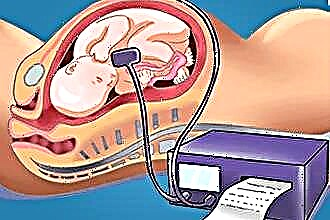The right ventricle of the heart (RV) is a chamber that coordinates the work of the pulmonary hemodynamic circle. The main task of the department is to transport blood saturated with carbon dioxide from the right atrium to the vessels of the lungs for oxygenation. The work of the pancreas depends on the functional state of the valve apparatus, the myocardium of the heart and the respiratory system. Insufficiency of the right sections is one of the reasons for generalized dysfunction of blood circulation, stagnation of venous blood in the body and pathologies of the lungs.
What is the right ventricle and how does it work?
Anatomy
The shape of the right ventricle is a triangular pyramid with the base up. The camera is located on the anterior surface of the heart and is delimited from the atrium by the coronal groove.
There are two sections of the cavity:
- near, located in the area of the right atrioventricular opening;
- anteroposterior, which continues into the cone of the pulmonary trunk.
 The inner surface of the chamber is lined with fleshy trabeculae (septa), and smooth in the anteroposterior part.
The inner surface of the chamber is lined with fleshy trabeculae (septa), and smooth in the anteroposterior part.
The RV cavity is connected to the right atrium and the lumen of the pulmonary artery through valves:
- Tricuspid (tricuspid). During atrial contraction, blood drawn from the vena cava penetrates through the atrioventricular opening. The valve cusps, which are attached to the annulus fibrosus with sutures (chords), open into the ventricular cavity. Sufficient filling of the chamber closes the dampers.
- Pulmonary valve. Blood enters the small circle of hemodynamics with each systole (contraction) of the ventricles. The valve is represented by three leaflets (left, right, front), the tight closure of which prevents the reverse flow of blood during relaxation (diastole) of muscle fibers.
The pancreas myocardium is supplied by the branches of the right coronary artery. The valve apparatus receives nutrients directly from the blood in the cavity.
The dimensions of the chamber and the thickness of the wall depend on the age of the person, the type of activity and the presence of concomitant pathologies.
Normative indicators of lifespan:
- volume in a newborn 8-11 cm3, adult - 150-220 cm3;
- wall thickness 0.45-0.86 cm;
- pressure: systolic (20-25 mm Hg), diastolic (0-2 mm Hg).
Microscopic structure
The histological structure of the wall is represented by three layers:
- Endocardium (internal) - a connective tissue membrane, covered with one row of epithelial cells, which lines the cavity from the inside, takes part in the formation of valves.
- Myocardium (muscular membrane), which consists of three layers of multidirectional fibers - oblique, annular and longitudinal. The individual bundles are held together by connective tissue for wall strength and high contractility.
- The epicardium is the outer membrane that covers the heart and synthesizes the pericardial fluid. The latter facilitates easy sliding of the chamber in the pericardial sac during systole and diastole.
The functional unit of the myocardium is a cardiomyocyte, the main types of which are presented in the table:
| Variety | Peculiarities |
|---|---|
| "Workers" |
|
| Conductive |
|
Main functions
The main function of the right ventricle is to release blood into the pulmonary system for oxygenation (oxygen saturation). The wall of the chamber is less thick (in comparison with the left sections), since pushing into the pulmonary vessels does not require a high load on the myocardium.
Negative intrathoracic pressure is an additional element that enhances the suction function of the atrium and facilitates the inflow from the vena cava to the right chambers.
Additional tasks of the pancreas:
- reservoir - a cavity in which an additional volume of blood is located;
- conductive - the presence of atypical cardiomyocytes in the wall contributes to the synchronous work of the ventricles.
The most common diseases
Pathological processes that impair the function of the right ventricle:
- hypertrophy (HPG) - the growth of muscle mass;
- insufficiency or narrowing (stenosis) of the pulmonary trunk;
- combined vices (tetrad or pentad of Fallot);
- chronic lung diseases (bronchial asthma, obstructive bronchitis)
- acute myocardial infarction (posterior, diaphragmatic wall);
- acute respiratory distress syndrome (ARDS).
Features of the course and clinical symptoms of diseases are presented in the table:
| Pathology | Development mechanism | Clinical picture |
|---|---|---|
| Pulmonary artery stenosis | The narrowed lumen of the outflow duct complicates the outflow of blood from the pancreas. An increase in intraventricular pressure causes additional tension of muscle fibers, their proliferation (hypertrophy) |
|
| Posterior myocardial infarction | Impaired blood flow in the right coronary artery leads to ischemia (oxygen starvation) and the death of a part of the organ. A decrease in the contractile function of the heart disrupts the process of oxygenation and outflow of blood through the vena cava |
|
| Gpw | An increase in the size of the walls, muscle mass of the myocardium due to increased resistance in the pulmonary trunk. The condition develops when:
|
|
| ARDS | Violation of the permeability of the capillaries of the lungs with systemic hemodynamic disorders. Plasma proteins that enter the alveoli are deposited and interfere with the oxygenation of the blood. Pathology occurs when:
|
|
What diagnostic methods are used to determine pathology?
Diagnosis of right ventricular pathologies requires a comprehensive assessment of the morphological structure and functional state of the chamber.
The most commonly used methods are:
- electrocardiography (ECG) - recording of myocardial bioelectric potentials, registration of rhythm disturbances;
- echocardiography (ECHO-KG) - an ultrasound method for visualizing structures and internal hemodynamics;
- chest x-ray - used to diagnose lung pathologies, changes in the contours of the heart;
- computed (CT) and magnetic resonance (MRI) tomography.
Features of ECG diagnostics for various disorders of the pancreas are presented in the table:
| Pathology | ECG changes |
|---|---|
| Right ventricular hypertrophy |
|
| Posterior myocardial infarction |
|
| Acute right ventricular failure |
|
Diagnosis of isolated pathologies of the right (posterior) parts of the heart requires the recording of additional chest leads: V3R, V4R, V5R, V6R.
X-ray research methods assess the relationship between the size of the heart and pulmonary fields.
The main guidelines for the analysis of the function of the right departments:
- lower arch on the right (RV contour);
- the second arch on the left (cone of the pulmonary artery) - swells with pathologies of the bronchopulmonary system, thromboembolism;
- displacement of the left border of the heart.
Echocardiography is the "gold standard" for diagnosing valvular defects and intracardiac hemodynamic disorders.
The method evaluates:
- dimensions of the right ventricle (diameter 7-26 mm, wall thickness 2-4 mm);
- the amplitude of the opening of the valve cusps (tricuspid and pulmonary trunk);
- pressure inside the chamber;
- direction of blood flow during systole and diastole;
- uniformity of the wall structure;
- narrowing and expansion of the cavity with cardiomyopathies;
- symmetry of contraction and relaxation (zones of hypo- and akinesia during a heart attack);
- the presence of intracavitary formations, defects (for example, the interventricular septum).
Tomographic studies using multidetector devices are used for accurate diagnosis of tumors (mix) of the heart, thrombosis and the consequences of ischemia. CT with additional administration of contrast agent is used to detect:
- calcification (calcification) of the walls of blood vessels and chambers;
- ventricular aneurysms - pathological bag-like protrusions with a thinned wall;
- valve defects.
Conclusions
The right ventricle determines the functional state of the pulmonary circulation, on which oxygen saturation of tissues depends. Violation of the pancreas is often associated with diseases of the respiratory or cardiovascular system. The appearance of signs of stagnation is a reason for contacting a therapist or cardiologist. Modern medicine offers many safe and informative methods for diagnosing pathologies in the early stages. Early initiation of treatment prevents complications and disease progression.



